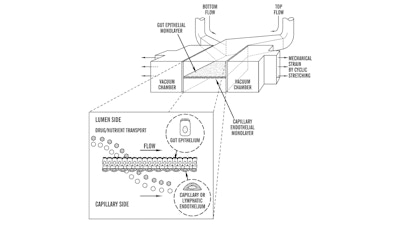Innovations in pathogen capture, DNA sequencing and CRISPR-Cas9 technologies, stretchable strain sensors for robotic applications, and more
To realize its overarching goal to invent and commercialize disruptive solutions for healthcare, energy, architecture, robotics, and manufacturing, the Wyss Institute is creating a patent portfolio in relevant areas that are or can become an essential basis for specific business development and commercialization efforts. To learn more about these innovations, contact our Business Development Team.
This Wyss Institute’s U.S. patents issued between April and June 2018 are as follows:

Microbe-binding molecules and uses thereof
US Patent 10,696,733 (June 30, 2020)
Alexander Watters, Brendon Dusel, Michael Super, Mark Cartwright, and Donald E. Ingber
Abstract: Described herein are engineered microbe-targeting molecules, microbe-targeting articles, kits comprising the same, and uses thereof. Such microbe-targeting molecules, microbe-targeting articles, or the kits comprising the same can not only bind or capture of a microbe or microbial matter thereof, but they also have improved capability (e.g., enhanced sensitivity or signal intensity) of detecting a microbe or microbial matter. Thus, the microbe-targeting molecules, microbe-targeting articles, and/or the kit described herein can be used in various applications, e.g., but not limited to assays for detection of a microbe or microbial matter, diagnostic and/or therapeutic agents for diagnosis and/or treatment of an infection caused by microbes in a subject or any environmental surface, and/or devices for removal of a microbe or microbial matter from a fluid.
Mutant Cas9 proteins
US Patent 10,683,490 (June 16, 2020)
Alejandro Chavez, Frank J. Poelwijk, and George M. Church
Abstract: Methods of making mutant Cas9 proteins are described.
Combination vaccine devices and methods of killing cancer cells
US Patent 10,682,400 (June 16, 2020)
Omar Abdel-Rahman Ali, David J. Mooney, and Glenn Dranoff
Abstract: The present invention comprises compositions, methods, and devices for enhancing an endogenous immune response against a cancer. Devices and methods provide therapeutic immunity to subjects against cancer.

Cell culture system
US Patent 10,655,098 (May 19, 2020)
Donald E. Ingber and Hyun Jung Kim
Abstract: The embodiments of the invention described herein relate to systems and methods for culturing and/or maintaining intestinal cells, tissues and/or organoids in vitro. The cells, tissues and/or organoids cultured according to the methods and systems described herein can mimic or reproduce natural intestinal epithelial structures and behavior as well as support co-culture of intestinal microflora.
RNA-guided transcriptional regulation
US Patent 10,640,789 (May 5, 2020)
George M. Church, Prashant G. Mali, and Kevin M. Esvelt
Abstract: Methods of modulating expression of a target nucleic acid in a cell are provided including introducing into the cell a first foreign nucleic acid encoding one or more RNAs complementary to DNA, wherein the DNA includes the target nucleic acid, introducing into the cell a second foreign nucleic acid encoding a nuclease-null Cas9 protein that binds to the DNA and is guided by the one or more RNAs, introducing into the cell a third foreign nucleic acid encoding a transcriptional regulator protein or domain, wherein the one or more RNAs, the nuclease-null Cas9 protein, and the transcriptional regulator protein or domain are expressed, wherein the one or more RNAs, the nuclease-null Cas9 protein and the transcriptional regulator protein or domain co-localize to the DNA and wherein the transcriptional regulator protein or domain regulates expression of the target nucleic acid.
Spatial sequencing of nucleic acids using DNA origami probes
US Patent 10,640,826 (May 5, 2020)
George M. Church, Richard C. Terry, and Frederic Vigneault
A method of sequencing nucleic acids is provided using DNA origami as a barcode for a nucleic acid probe.

Insole design and actuator placement for balance and gait
US Patent 10,617,597 (April 14, 2020)
Arun Chawan, Hani Sallum, Robert Wood, James Niemi, and James J. Collins
Abstract: A wearable system is directed to neurological stimulation of a human foot, and includes a controller with at least one bias signal generator for outputting a driving signal. The system further includes a power source that provides electrical energy to the controller, including providing electrical energy to the bias signal generator. The system also includes a platform in the form of an insole insert of a shoe, the insole insert having a plurality of actuators positioned in a medial arch region of the foot. The plurality of actuators stimulate the medial arch region in response to receiving the driving signal from the controller. The stimulation of the plurality of actuators provides a subthreshold bias signal to target cells with a subthreshold bias signal magnitude that is below a threshold where the target cells are activated by a stimulus. The plurality of actuators is surrounded with a vibration dissipating material.
Printed stretchable strain sensor
US Patent 10,612,986 (April 7, 2020)
Jennifer A. Lewis, Joseph T. Muth, Daniel M. Vogt, Ryan L. Truby, Yigit Menguc, David B. Kolesky, and Robert J. Wood
Abstract: A printed stretchable strain sensor comprises a seamless elastomeric body and a strain-sensitive conductive structure embedded in the seamless elastomeric body. The strain-sensitive conductive structure comprises one or more conductive filaments arranged in a continuous pattern. A method of printing a stretchable strain sensor comprises depositing one or more conductive filaments in a predetermined continuous pattern into or onto a support matrix. After the depositing, the support matrix is cured to embed a strain-sensitive conductive structure in a seamless elastomeric body.
